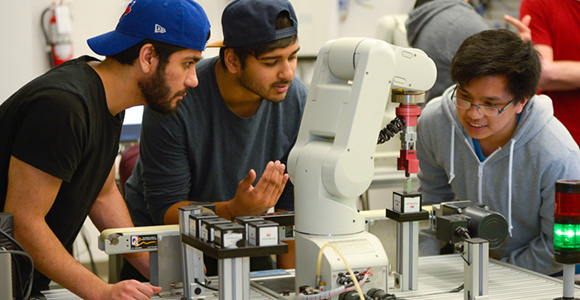
Mohawk College co-op students (Photo: Mohawk College)
California Community Colleges have undergone significant changes in the last few years as a response to the looming skills and job gap. Although many Californians may be unaware of just how much transformation has occurred – Canada isn’t and wants to know more!
This week the Chancellor’s Office hosted three Canadian officials to discuss the topic – specifically how the revival of the workforce development message helped to define and ignite a system change movement. It turns out our neighbors to the north have plenty of educational innovations to be proud of.
Similar to federalism in the United States, Canada’s provinces have complete autonomy over their educational systems and Ontario’s Office of the Premier is focused on removing financial barriers to higher learning for many of the same motivations as California – social mobility, job creation, and a strong economy and community.
Ontario Canada’s Ministry of Advanced Education and Skills Development is launching “co-operative education” – a system of experiential and work-integrated learning. These programs are meant to alternate between periods of academic study and work experience in a related field, where a student would spend one semester at school learning the concepts and the following semester at work, applying the concepts and getting paid for the work!
Embracing the true intention behind the word co-op – and possibly an answer to California’s employer engagement quandary – the working semesters are put on through partnerships with employers. Employers seek the opportunity to strengthen their own pipelines, while providing productive learning experiences for students.
During the semester of work, employers are able to evaluate and provide feedback on the student’s performance – sounds similar to the new soft skill curriculum developed by California Community College’s New World of Work and the development of employer-verified digital badges.
For the 2014-2015 school year, Ontario had 90,613 students enrolled in 1,186 co-op programs and since then, the University of Waterloo has been acknowledged as a world leader in co-op education with 6,700 employer partners!
Ontario offers a refundable tax credit to employer to incentivize and strengthen participation in the Co-op Education system. Although the success of this tactic is still being evaluated, Ontario is obviously dedicated to including both small and large businesses in the system and making sure students are treated like employees – including getting paid!
Not to be outdone, California Community Colleges and the progress they've made reinvigorating workforce training programs impressed the visiting Canadians – and we should be proud of that!
Under the leadership of Vice Chancellor Van Ton-Quinlivan, the system has embraced a renewed workforce mission under the Doing What Matters for Jobs and the Economy framework that repurposes community colleges as essential catalysts for a strong California economy and an essential lever to increase social mobility.
California Community Colleges are the best place for intervention – connecting all types of students to greater opportunity. With identical demographics, community colleges represent the richness of our state’s diversity and are emerging as a primary lever to rejuvenate California’s middle class and improve the quality of life for those living in poverty.
Over the last few years, the community college system has taken significant steps towards total reform – an ecosystem of intrapreneurs, driven by labor market data, and dedicated to bringing high performing innovative programs to scale. A big part of this change can be dedicated to regionalism – encouraging coordination and collaboration among the 113 colleges to do what matters for their regional economy.
To facilitate this shift, a new organizational structure was created. All of California’s fifteen regions were given a Regional Consortia Chair (RC) to help facilitate some of the collaboration with Sector Navigators (SN) to represent the state’s 10 priority industry sectors. Under the RC and SN, are the Deputy Sector Navigators (DSN) who represent the priority sector for a specific region and act as a liaison between business and college in that community.
Once the structure was in place, the system focused freeing and aligning data metrics and innovating processes and programs to better benefit students and employers. A new Strong Workforce Program provides $200m annual funds for more and better career technical education and requires public, private, and civic players to work together to allocate the investment in a way that best addresses the needs of the region.
With heightened attention on California Community Colleges to lead the nation as educational incubators for innovation – maker movement, rebirth of vocational training through new investments in career technical education, better preparing students for jobs through guided pathways, implementing mobile apps to connect students to high paying careers – our Golden State is just at the beginning of this transformational journey and may want to look to Canada for future inspiration.

